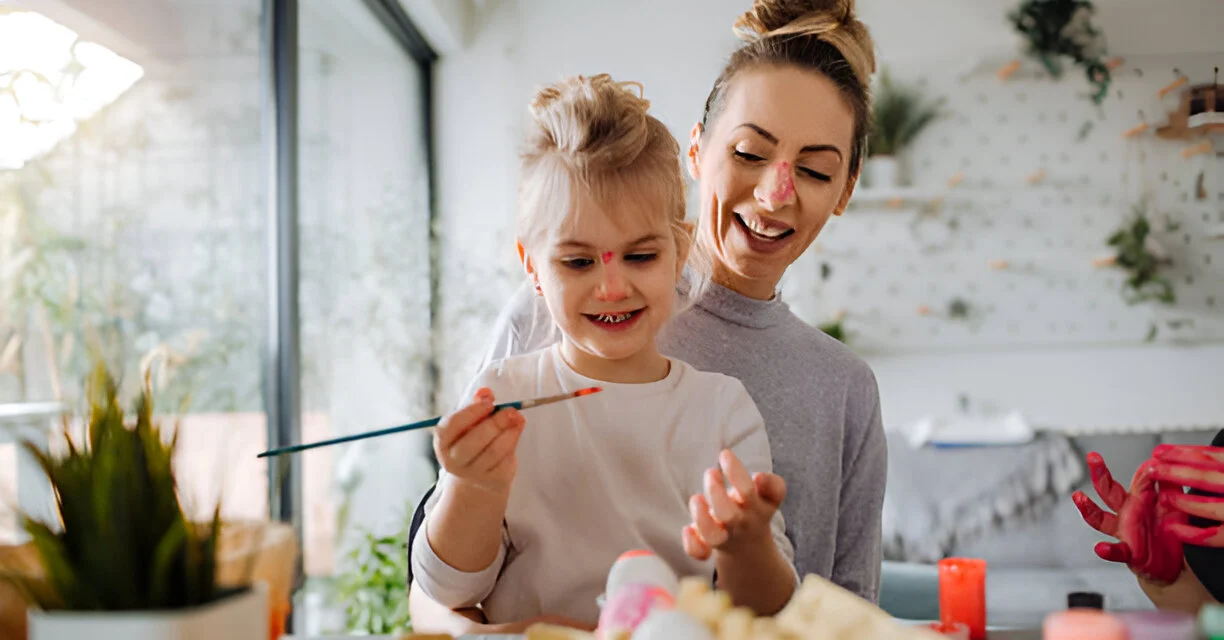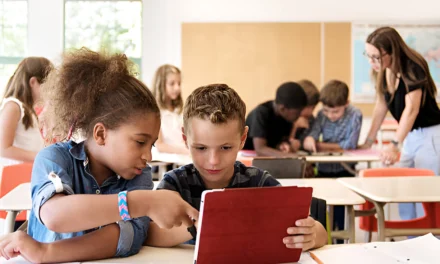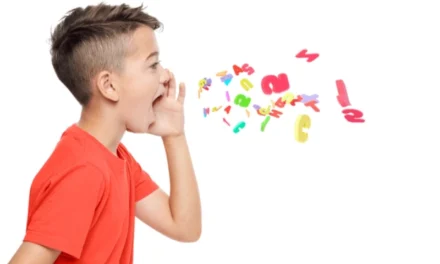Many think creativity is something you’re born with. But, with the right support and setting, we can help kids grow their creative skills. Creativity at home plays a crucial role in nurturing this growth. They can then show off their imagination. Creativity shows up in many ways, like drawing, writing, dancing, and more.
Children who think creatively do well in school and have better skills1. So, it’s key to help our kids be creative and imaginative.
Key Takeaways
- Creativity can be nurtured and developed in children through the right environment and encouragement.
- Creativity comes in many forms and can benefit children’s academic and cognitive development.
- Nurturing creativity at home is essential for helping children reach their full potential.
- Strategies for nurturing creativity include providing creative resources, allowing unstructured time, and encouraging role-play and different creative expressions.
- Parents can lead by example and foster a balanced creative space to support their children’s creativity.
The Importance of Nurturing Creativity at Home
Creativity shows up in many ways, like drawing, painting, and writing2. It’s especially important in today’s fast world3. Helping your child be creative and imaginative is key.
Creativity in Different Forms
There are many ways to be creative, like arts and crafts, play, and solving problems3. These activities help kids grow their artistic skills and improve thinking and teamwork3.
Benefits of Creative Thinking Skills
Research shows kids with creative skills do well in school and think better2. But, there’s a problem: American kids are becoming less creative2. This might be because we focus too much on tests and goals, which can stop their curiosity2.
We need to help our kids be creative at home3. By letting them explore and play freely, we can help them grow and succeed3.
“Creativity is just connecting things. When you ask creative people how they did something, they feel a little guilty because they didn’t really do it, they just saw something. It seemed obvious to them after a while.” – Steve Jobs
Provide a Creative Home Environment
Creating a Creative Home Environment is key for your child’s Creativity at Home. When kids feel at ease, they’re more likely to be creative. Let them think, play, and explore freely. This way, their ideas can grow and their creativity can bloom4.
Unstructured time is vital for a Creative Home Environment. It lets kids’ imaginations run wild and boosts problem-solving skills4. Also, cutting down on screen time and using open-ended toys encourages creative play4.
Mixing up the creative space is another important step. Changing settings can prevent boredom and spark new ideas4. Role-play also helps with problem-solving and creative thinking4.
A Creative Home Environment is where your child feels safe and supported. It’s where they can explore their ideas and talents freely. By nurturing their curiosity and letting them make mistakes, you help them develop important skills for the future5.
| Key Aspects of a Creative Home Environment | Benefits |
|---|---|
| Unstructured Time | Develops creative mindset and problem-solving skills |
| Reduced Screen Time | Encourages imaginative play and creative expression |
| Open-Ended Toys | Promote imaginative play and foster creativity |
| Changing Surroundings | Prevents boredom and sparks imagination |
| Encouraging Role-Play | Develops problem-solving and creative thinking skills |
By making your home a Creative Home Environment, you encourage your child’s curiosity. You help them embrace their uniqueness and develop the skills needed for success in the 21st century5.
“Mistakes and failures are part of the creative process and should be accepted and encouraged in a nurturing environment.”
Have Creative Resources To Hand
Boosting creativity at home doesn’t need to cost a lot. With a variety of Creative Resources at your fingertips, your child’s curiosity and imagination can grow. Even the simplest Affordable Supplies can spark creativity, thanks to a bit of Repurposing of everyday items.
Affordable Creative Supplies
Start with the basics like crayons, markers, colored pencils, and sketch pads6. Make sure the supplies match your child’s age and developmental stage6. You can find great art supplies at craft stores or dollar stores without spending too much6.
Repurposing Household Items
Explore your home for creative reuse. Cardboard boxes, empty toilet paper rolls, and old magazines can inspire your child’s next project6. Use surfaces that are easy to clean when working with messy materials like paint6. With a dash of imagination, you can turn simple items into creative wonders.
“Creativity is intelligence having fun.” – Albert Einstein
By offering Creative Resources and encouraging Repurposing, you foster your child’s creativity and spark their imagination6. The secret is to keep it simple, fun, and accessible!
Invest In Open-Ended Toys

Investing in open-ended toys is a smart move for boosting creativity at home. These toys offer endless possibilities for play. From blocks and building sets to toy animals and dress-up, they encourage kids to think creatively7.
Open-ended toys are different from traditional ones. They let kids explore and express themselves in many ways. This helps with problem-solving, boosts confidence, and enhances communication7.
- Blocks and building sets improve spatial awareness and problem-solving skills.
- Dress-up clothes and accessories spark imagination and emotional expression.
- Art supplies like paints, crayons, and playdough help kids develop creativity and fine motor skills.
- Sensory bins with different materials stimulate touch and sensory development.
Buying open-ended toys means investing in endless possibilities for your child. These toys help kids think creatively and engage in meaningful play8.
Adding open-ended toys to your child’s play area sets the stage for a lifetime of creativity and problem-solving. These versatile toys can unlock your child’s full potential8.
Nurturing Creativity
Encouraging curiosity is key to unlocking your child’s creative potential. By posing open-ended questions, you can inspire them to think outside the box and explore their ideas in unique ways9. In schools of Reggio Emilia, Italy, a high priority is placed on listening to children, particularly through conversations based on open-ended questions without a defined “right” answer9.
Encouraging Curiosity
Ask questions that provoke deeper thinking and inspire your child to come up with their own solutions. Instead of closed-ended questions that elicit a simple “yes” or “no” response, try using open-ended questions that start with words like “what,” “how,” or “why.” For example, you might ask, “What do you think would happen if we added water to the clay?” or “How can we do this differently?” These types of questions not only encourage creative thinking but also inspire kids to ask more questions of their own9.
Asking Open-Ended Questions
Open-ended questions are a powerful tool for nurturing creativity. They allow your child to explore their ideas, express their thoughts, and engage in critical thinking10. Encouraging curiosity and intellectual engagement can foster openness and creativity, especially in childhood and adolescence10. By asking questions like “Why did you do it that way?” or “What was most challenging?” you can gain insight into your child’s thought process and help them develop their problem-solving skills9.
Remember, the goal is to create an environment where your child feels safe to experiment, take risks, and express their unique perspective. Establishing a foundation of respect in your parent-child relationship can go a long way in fostering this type of supportive and nurturing environment9.
Allow Unstructured Time
Creativity blooms when kids explore freely. Research shows too much scheduling can stress kids out11. It’s key to balance structured and free time.
Creativity Needs Room to Breathe
Relaxed hours a day boost creativity in kids. Boredom can spark their imagination11. Free play is vital for creative growth.
Too much screen time can harm creativity11. Parents should set limits on digital use. Showing creativity yourself helps kids see its value11.
Reducing busy schedules makes room for downtime11. This lets kids relax and recharge. Celebrating their creativity encourages more imagination11.
Unstructured play is 40% of a child’s time and is essential12. Kids who play freely do better in social skills, with a 15% boost12. They also solve problems 20% better and think critically12.
Unstructured play makes kids curious and love learning 25% more12. It also improves physical skills like balance by 30%12. Fine motor skills grow 10% faster in free play12.
Reduce Screen Time

Too much screen time can hold back a child’s creativity13. Instead of exploring and learning, kids get lost in what’s on the screen14. This can make them less likely to play imaginatively and solve problems14.
Encourage your child to play and create, not just watch screens13. Games that teach can help kids learn and grow13. But, it’s key to mix digital time with activities that spark creativity and imagination15.
- Childhood Obesity Prevention: Less screen time can help prevent obesity in kids13.
- Social Skills Development: Kids learn important social skills by spending less time on screens13.
- Boredom as a Catalyst: Boredom can spark creativity and imagination in kids, letting their minds roam and come up with new ideas15.
By cutting down on screen time and encouraging open-ended play, you can boost your child’s creativity and prepare them for the future1415.
Find a balance between digital media and hands-on creativity. This mix can equip your child with the skills needed to succeed in today’s world1415.
Mix Up The Creative Environment
Creativity grows when you explore new places16. Kids get bored if they stay in the same spot too long16. So, it’s key to change things up and take them on adventures16.
Take toys to the garden, go to the park, or explore woods and museums. These trips spark their imagination and open up new creative paths16.
Exploring New Surroundings
Leaving the usual spot can open up a world of creativity for kids16. Going outside, whether it’s the backyard or a park, introduces new sights and sounds16. It also lets them play with natural materials, inspiring new ideas16.
Visiting museums and art galleries lets kids see the work of others. It broadens their view and sparks their own creativity16.
Changing up where and what they play with keeps things exciting and prevents boredom16. Regularly introducing new places and things keeps their creativity alive and curiosity sharp16. This variety helps their imagination grow and teaches them to solve problems and adapt16.
Finding the right balance is important16. Kids need routine but also need to explore and discover16. A varied creative space helps them reach their full potential and love learning and creating for life16.
Encourage Role Play
Creating role play situations with your children is a great way to boost their creativity. It sparks their imagination. Studies show that children who play pretend during preschool years are more creative and innovative17. This makes it a valuable tool for their growth.
Role play is not only fun but also helps kids solve problems in real life. Children over three can tell the between what’s real and what’s not18. This skill helps them understand the difference between fantasy and reality.
Role Play Ideas
Here are some fun role play ideas for your little ones:
- Doctors
- Police officers
- Shopkeepers
- Teachers
- Superheroes
- Fantasy characters like unicorns, dinosaurs, or princesses
Pretend play boosts neural plasticity, improving cognitive development by creating new neural connections17. It also helps kids learn social cues, emotions, and communication by activating mirror neurons17.
Through role play, children can explore different scenarios and perspectives. This fosters empathy, responsibility, and problem-solving skills. Pretend play also enhances memory and spatial navigation by engaging the hippocampus17. It improves language skills by teaching new words, complex conversations, and sentence structure17.
So, dive into the world of role play with your little ones. Watch their creativity and problem-solving skills grow!
“Pretend play is scientifically proven to be essential for child development, nurturing creativity, social skills, problem-solving abilities, and cognitive functions.”
Embrace Different Creative Expressions
In the pursuit of nurturing creativity at home, it’s key to welcome many creative expressions. Don’t let the idea of what’s “supposed” to be limit you. Encourage your kids to let their imagination run wild without strict rules. This is where the magic of creativity truly shines.
Creativity comes in many forms. It can be seen in painting, playing music, telling stories, or cooking. Exploring these different areas helps kids find what they love and grow as individuals.
Exploring various creative outlets can greatly improve well-being. Creativity boosts problem-solving skills19 and learning from failure increases creative potential19. Being around different art forms can spark creativity19.
Creating a home that values creative expressions empowers kids to explore freely. This encourages self-discovery and a lifelong love for the arts.
The heart of creativity is in being true to oneself. Make your home a place where everyone’s unique talents are celebrated. See how it positively affects their growth and happiness20.
“Creativity is a way of living life, not just a skill to be applied now and then.” – Deepak Chopra
Lead by Creative Example
As a parent, your actions are more powerful than words in fostering creativity at home. Children learn more from what you do than what you say, so being creative yourself encourages them to be the same21. By showing a willingness to try new things and fail, you teach them that everyone can be creative in many ways21.
Inviting your kids to help with projects like rearranging furniture or planting a garden can be fun22. Having a special area for creativity in your home can also help22. By leading by example, you not only boost their creativity but also grow closer as a family through shared experiences21.
Creativity has many forms, and there’s no one “right” way to express it. The key is to be willing to experiment, take risks, and have fun with the process.22 As you explore creativity together, you’ll also improve skills like problem-solving and emotional intelligence21.
So, don’t be shy about showing your creative side – your kids will be inspired by your Creative Example and excited to join you in your Nurturing Creativity journey2122.
Foster a Balanced Creative Space
Creativity can be messy, but cleanliness shouldn’t rule. Many parents feel they must always keep things spotless. This can make kids think their creative play is a bother23.
To find a balance, keep essential cleanup tools nearby. Have a plastic tablecloth, aprons or smocks, and old newspapers ready. Also, place a trash can, recycling bin, and rags or paper towels where arts and crafts happen. If messy projects worry you, set them up outside23.
Allowing Mess and Clutter
Give your children’s creativity the space it needs, even if it means a bit of mess and clutter24. Embrace the chaos of their creative process. Avoid constantly cleaning up. This lets their imagination flow freely without limits24.
Setting Up for Cleanup Success
While you don’t want to stop creativity, teaching kids to clean up is key. Teach them to prep the area, protect surfaces, and tidy up when done. This teaches them responsibility and shows creativity and cleanliness can go together23.
By creating a balanced creative space, you support your children’s imagination while keeping your home livable. With some planning and openness, you can enjoy the messy, boundless creativity at home24.
Nurturing Creativity
Stepping Back and Letting Creativity Flow
Now, it’s time to let your child’s creativity shine25. Move from guiding to supporting their creative journey. Be ready to help if needed, but let them lead their way26.
Don’t try to control what they create. Creativity is all about surprises. If it’s different from what you thought, that’s okay! It shows they’re fully into the creative process26.
Stepping back shows you trust their creativity. It tells them they can explore freely. This builds their confidence and love for Nurturing Creativity26.
So, enjoy the surprises and celebrate their uniqueness. As a nurturing parent, give them the tools and encouragement. Then, let their creative process take over26.
Conclusion
Nurturing creativity at home is a rewarding journey. It lets you create a space where your child can explore freely. This environment is key to unlocking their full potential.
By giving your child access to resources and encouraging open-ended exploration, you help them grow. Creativity is essential in today’s learning world. It helps students connect different subjects in new ways.
Engage in activities that bring you and your child together. Show them different ways to be creative. This way, you create a space where their imagination can run wild.
By doing this, you help your child grow in ways that will serve them well in the future. They’ll be ready for the changing world of education.
This article is just the start of your family’s creative journey. Embrace the power of creativity at home. Watch as your child’s imagination reaches new heights.
Remember, the most important thing is to support their creativity. Give them the space, resources, and opportunities they need to thrive.





